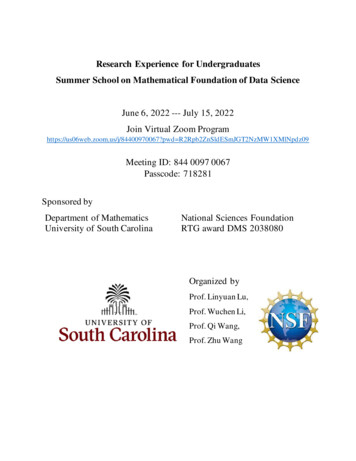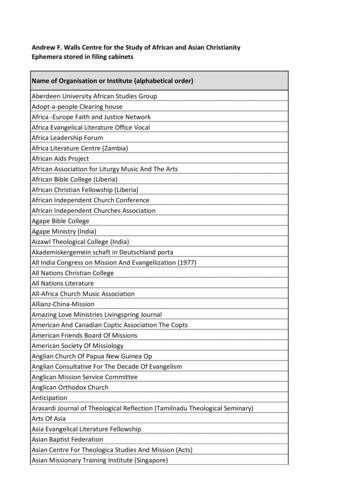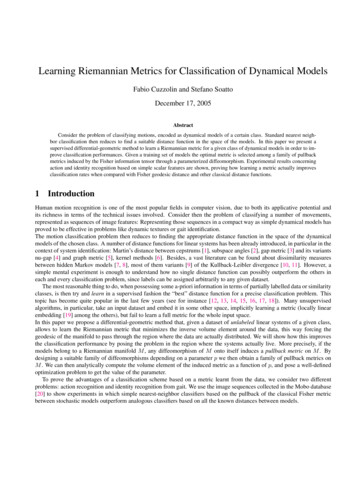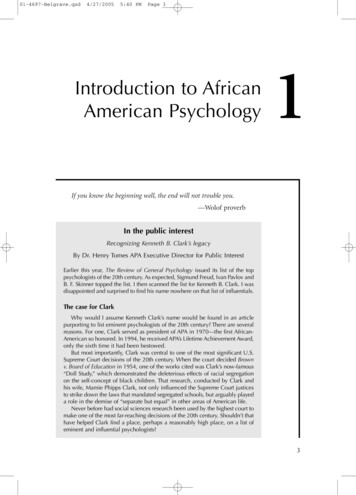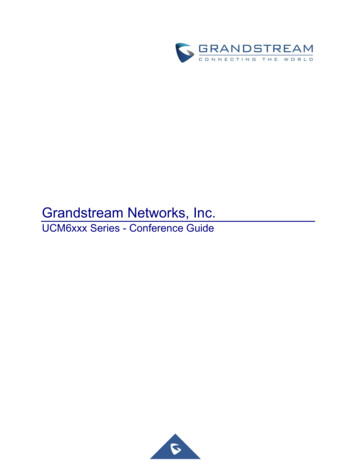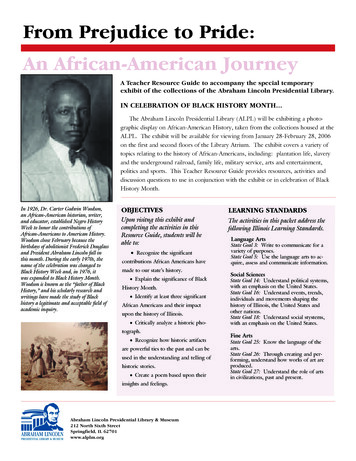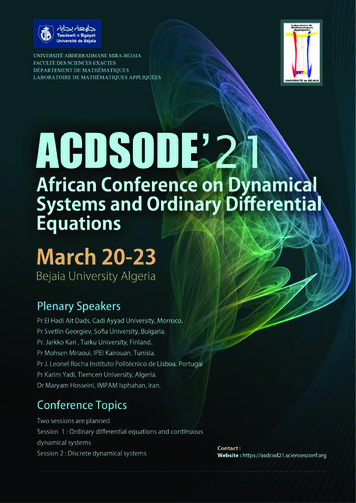
Transcription
African Conference on Dynamical Systemsand Ordinary Differential EquationsACDSODE 21 March 20-23 2021Laboratory of Applied MathematicsBejaia University, Algeria
African Conference on Dynamical Systemsand Ordinary Differential EquationsACDSODE 21 March 20-23 2021Bejaia University, AlgeriaThe conference aims to regroup African researchers working in the field of dynamicalsystems in a broad sense. This includes a wide range of research directions, Stability ofordinary differential, discrete dynamical systems, chaos, bifurcations, topological and symbolic dynamics and their applications that are at least as rich and diverse.The academic program of the conference will consist of invited talks and paper presentations. Two sessions are planned, the first one for Ordinary Differential Equationsand Continuous Dynamical Systems (ODE/CDS) and the second for Discrete Dynamicalsystems (DDS).The organizers hope that ACDSODE will become a regular event in the continent andwill help to create links between African mathematicians working in this exciting field.Due to the Covid 19 pandemic this edition will be held online.Plenary SpeakersPr. El Hadi Ait Dads, Cadi Ayyad University, Morocco.Pr. Svetlin Georgiev, Sofia University, Bulgaria.Pr. Jarkko Kari , Turku University, Finland.Pr. Mohsen Miraoui, IPEI Kairouan, Tunisia.Pr. J. Leonel Rocha Instituto Politécnico de Lisboa, Portugal.Pr. Karim Yadi, Tlemcen University, Algeria.Dr. Maryam Hosseini, IMPAM Isphahan, Iran.Conference TopicsTwo sessions are planned:Session 1 : Ordinary differential equations and continuous dynamical systems.Session 2 : Discrete dynamical systems.1
ACDSOD 21 Bejaia, March 20-23 2021Scientific committeePr. Nourredine AkrounePr. Ahmed BerbouchaPr. Karima MebarkiDr. Fatiha BoulahiaDr. Nadia MohdebOrganizing committeePr. Ahmed BerbouchaDr. Leila BaicheDr. Mohand BouraineDr. Rezki ChemlalDr. Hacene Gharout2
African Conference on Dynamical Systemsand Ordinary Differential EquationsACDSODE 21 March 20-23 2021Bejaia University, AlgeriaProgramSession 1 :Session 2 :ODE / Continous dynamical systemsDiscrete dynamical systems.Saturday 20/03/2021Session ODE/ CDS: Chairman N. Mohdeb09h00-09h30: Opening09h30-10h30: Yadi Karim. University of Tlemcen, Algeria.”Sur les modèles de prédation avec taux de disparition non constant.”10h30-11h00: Tinhinane Meziani. University of Bejaia, Algeria.” Etude de la dynamique d’un modèle biomathématique régi par un système d’équationsdifférentielles ordinaires. ”11h00-11h30: Houdeifa Melki. University of BadjiMokhtar Annaba, Algeria.”Limit cycles for a class of generalized kukles differential systems. ”11h30-12h00: Abdessalem Benterki. University of Medea, Algeria.”Study the seiqrdp model of covid-19 in Algeria. ”BreakSession ODE/ CDS : Chairman K.Mebarki13h30-14h30: Svetlin Georgiev. Sofia university, Bulgaria.” Applications of the Fixed point Theory.”14h30-15h00: Zouaoui Bekri University of Oran 1, Algeria.”Existence of solution for a third-order boundary value problem. ”Break3
ACDSOD 21 Bejaia, March 20-23 202115h30-16h00: Ghendir Aoun Abdellatif. Faculty of Exact Sciences, HammaLakhdar University, Algeria.”Nonlocal Integro-Differential Boundary Value Problem for Fractional Differential Equation on An Interval Infinite. ”16h00-16h30: Safa Chouaf. University of 20 August 1955 Skikda, Algeria.”New Results on positive bounded solutions of a second-order iterative functional differential equation. ”16h30-17h00: Rabah Belbaki. ENS Kouba, Algiers, Algeria.”On the monotone generalized non expansive mapping in Banach spaces. ”17h00-17h30: Ibtissem Merzoug. University Badji Mokhter Annaba, Algeria.”Existence of solutions for a nonlinear fractional p-Laplacian boundary value problem. ”17h30-18h00: Moussa Haoues. Souk-Ahras University , Algeria.”Existence and uniqueness of solutions for the nonlinear fractional differential equationswith nonlocal conditions. ”Sunday 21/03 /2021Session DDS : Chairman N.Akroune09h00-10h00: J. Leonel Rocha. Polytechnic Institute of Lisbon, Portugal.”Lambert W function in the stability and bifurcation analysis of homographic Rickermaps.”10h00-10h30: Faiza Zaamoune. University Mohamed Khider, Biskra, Algeria.” Discovering Hidden Bifurcation in Chua system Via Transformation. ”10h30-11h00: Nouressadat Touafek. Mohamed Seddik Ben Yahia University,Jijel, Algeria.” On the behavior of the solutions of a system of difference equations of second orderdefined by homogeneous functions. ”11h00-11h30: Hacene Gharout. University of Bejaia, Algeria.” Evolution of a three-dimensional endomorphism towards hyper chaos ”11h30-12h00: Bououden Rabah. Abdelhafid Boussouf University Center, Mila,Algeria. ” Chaos in the Fractional Lozi Map. ”Break4
ACDSOD 21 Bejaia, March 20-23 202113h30-14h00: Nouar Chorfi. University of Tebessa, Algeria.”Stability analysis and an optimal control applied to the spread of HIV/AIDS model.”14h00-14h30: Yahiaoui Yaniss. University of Bejaia, Algeria.” Sur les bifurcations d’un certain système dynamique discret. ”BreakSession ODE/CDS: Chairman A. Berboucha15h00-15h30: Nasri Akila. University of Bejaia, Algeria.” La reduction de R : Smith et application”.16h00-16h30: Kamel Ali Khelil. University of 8 May 1945 Guelma, Algeria.”On the stability of certain nonlinear delay dynamic equations. ”16h30-17h00: Samir Cherief. University Abdelhamid Ibn Badis of Mostaganem,Algeria.”Growth of solutions of a class of linear differential equations near a singular point. ”17h00-17h30: Bouharket Benaissa. University of Tiaret, Algeria.”New proof of Hardy dynamic Integral Inequality on Time Scales. ”17h30-18h00: Amira Ayari. University of Badji Mokhtar Annaba, Algeria.”Sufficient conditions for exponential stability of some nonlinearperturbed system on timescales.”Monday 22/03/2021Session ODE/CDS : Chairman F. Boulahia09h00-10h00: El Hadi Ait Dads. University Cadi Ayyad, MOROCCO.”Discrete Pseudo Almost Periodic Solutions for Some Difference Equations. ”10h00-10h30: Mesbah Chebbab. University of Tizi Ouzou, Algeria.”Pseudo almost periodic solution for the Nicholson Blowflies model with Stepanov pseudoalmost periodic coefficients. ”10h30-11h00: Mohamed Abdelhak Kara. University Abdelhamid Ibn Badisof Mostaganem, Algeria.”Fast growing and fixed points of solutions of complex linear differential equations. ”11h00-11h30: Fayal Bouchelaghem. University 8 Mai 1945 of Guelma, Alge5
ACDSOD 21 Bejaia, March 20-23 2021ria.”Existence of positive solutions for dynamic equations on time scales. ”11h30-12h00: Benadouane Sabah. University of Bordj Bou Arreridj, Algeria.”Explicit non-algebraic limit cycle of a family of polynomial differential systems of degreeeven. ”Break13h30-14h30: Mohsen Miraoui. University of Kairouan, Tunisia.”On the integro-differential equations with reflection. ”14h30-15h00: Omar Benniche. Djilali Bounaama University, Ain Defla, Algeria.” Null–controllability for systems governed by fully nonlinear differential equations. ”Break15h30-16h00: Rebiha Benterki. Bordj Bou Arréridj University, Algeria.” Limit cycles of a family of discontinuous piecewise linear differential systems separatedby conics. ”16h00-16h30: Rachid Boukoucha. University of Bejaia, Algeria.”Algebraic and non-algebraic limit cycles of a family of planar differential systems.”16h30-17h00: Saad Eddine Hamizi. University of Bejaia, Algeria.”A class of planar differential systems with explicit expression for two limit cycles.”17h00-17h30: Mouna Yahiaoui. University of Bejaia, Algeria.”Invariant algebraic curves and the first integral of a class of Kolmogorov systems.”17h30-18h00: Ahlam Belfar. Bordj Bou Arréridj University, Algeria.”Global Phase Portraits of some Quadratic systems having reducible invariant curve.”Tuesday 23/03/2021Session DDS : Chairman R.Chemlal09h00-10h00: Jarkko Kari. Turku University, Finland.”Decidability in Group Cellular Automata.”10h00-10h30: Rezki Chemlal. University of Bejaia , Algeria.”Periodicity and factors of endomorphisms of the shift.”6
ACDSOD 21 Bejaia, March 20-23 202110h30-11h00: Saliha Djenaoui. University of 8 May 1945, Algeria.”Overview of the generic limit set.”11h30-12h00: Tarek Sellami. University of Sfax, Tunisia.”Common dynamics of Rauzy fractals with the same incidence matrix.”Break13h30-14h30: Maryam Hosseini. Institute for Research in Fundamental Sciences (IPM), Iran.”Topological rank of cantor factors of cantor minimal systems. ”14h30-15h00: Aymen Hadj Salem. Higher Institute of Management of Gabés,Tunisia.”On recurrence in dendrite flows.”Break15h30-16h00: Mohammed Salah Abd Elouahab. Center AbdelhafidBoussouf, Mila, Algeria.”On some stability conditions for fractional-order dynamical systems of order alpha in[0, 2) and their applications to some population dynamic models.”16h00-16h30: Hamdi Brahim. University of Mostaganem, Algeria.”Etude d’un problème à conditions aux limites non locales généralisées de type BitsadzeSamarskii dans les espaces Lp. ”16h30-17h00: Karima Ait-Mahiout. Higher Normal School, Algeria.”Solutions multiples pour un problème aux limites poste sur la demi-droite réelle par lathéorie de Morse. ”17h00-17h30: Smaı̈l Kaouache. Centre universitaire de Mila, Algeria.”Chaos and mixed combination synchronization of three identical fractional hyperchaoticsystems with different fractional-order. ”17h30Closing7
ACDSOD 21 Bejaia, March 20-23 2021ConferencesPlenary Speakers :1. Pr. El Hadi Ait Dads. Cadi Ayyad University, Morocco.2. Pr. Svetlin Georgiev. Sofia University, Bulgaria.3. Dr. Maryam Hosseini. IMPAM Isphahan, Iran.4. Pr. Jarkko Kari. Turku University, Finland.5. Pr. Mohsen Miraoui. IPEI Kairouan, Tunisia.6. Pr. J. Leonel Rocha. Instituto Politécnico de Lisboa, Portugal7. Pr. Karim Yadi. Tlemcen University, Algeria.8
ACDSOD 21 Bejaia, March 20-23 2021Sur les modèles de prédation avec taux de disparition nonconstantA. Hammoum, K. Yadi and T. SariNous proposons l’étude d’un modèle proie-prédateur général dans lequel le taux de disparition est une fonction dépendant de la densité des espèces. Il s’agit aussi d’une tudecomparative avec les modèles existant dans la littrature en prcisant dans quelle mesurenotre modèle les contient et ce qu’il apporte de nouveau. Nous mettrons en vidence lapossibilit d’avoir une bifurcation de Hopf et une discussion est mene sur le paradoxe del’enrichissement du milieu. Nous dirons deux mots sur ce type de modèle lorsque le rendement est considr comme très petit.Mots clès: Modèle proie-prédateur, Mortalité non constante, Bifurcation de Hopf, Paradoxe de l’enrichissement.9
ACDSOD 21 Bejaia, March 20-23 2021On the integro-differential equations with reflectionMohsen MiraouiMaitre de conférences en Mathématiques Universit de KairouanAbstract: By developing important properties on the composition of functions with reflection, using some exponential dichotomy properties and an application of the fixed pointtheorem, several new sufficient conditions for the existence and the uniqueness of an pseudoalmost automorphic solutions with measure for some general type reflection integro differential equations. We suppose that the nonlinear part is measure pseudo almost automorphic and in which we distinguish the two constant and variable cases for the Lipschitzcoefficients of the functions associated with this part. It is assumed that the linear part ofthe equation considered admits an exponential dichotomy. Finally, an application is givenon the very interesting model of Markus and Yamabe.References1. Elhadi Ait Dads, Safoua Khelifi and Mohsen Miraoui, On the integro-differentialequations with reflection, Mathematical Methods in the Applied Sciences, (2020).10
ACDSOD 21 Bejaia, March 20-23 2021Decidability in Group Cellular AutomataJarkko KariMany undecidable questions concerning cellular automata are known to be decidable whenthe cellular automaton has a suitable algebraic structure. Typical situations include linearcellular automata where the states come from a finite field or a finite commutative ring,and so called additive cellular automata in the case the states come from a finite commutative group and the cellular automaton is a group homomorphism. In this talk wegeneralize the setup and consider so-called group cellular automata whose state set is any(possibly non-commutative) finite group and the cellular automaton is a group homomorphism. The configuration space may be any group shift - a subshift that is a subgroupof the full shift - and still many properties are decidable in any dimension of the cellularspace. Our decidability proofs are based on algorithms to manipulate group shifts, andon viewing the set of space-time diagrams of group cellular automata as multidimensionalgroup shifts. The trace shift and the limit set of the cellular automaton are lower dimensional projections of the space-time diagrams and they can be effectively constructed. Thisview provides algorithms to decide injectivity, surjectivity, equicontinuity, sensitivity andnilpotency of the cellular automaton. Non-transitivity is semi-decidable. We also easilyestablish that injectivity always implies surjectivity, that transitivity implies mixingness,that non-sensitivity implies equicontinuity, and that jointly periodic points are dense inthe limit set. The talk is based on a joint work with Pierre Baur.References1. Pierre Baur, Jarkko Kari. Decidability in Group Shifts and Group Cellular Automata. In: Proceedings of MFCS 2020. Leibniz International Proceedings in Informatics (LIPIcs) 170, 12:1-12:13, 2020.11
ACDSOD 21 Bejaia, March 20-23 2021Topological rank of cantor factors of cantor minimal systemsMaryam Hosseini and Nasser GolestaniSchool of Mathematics, Institute for Research in Fundamental Sciences (IPM),P. O. Box 19395-5746, Tehran, IranEmail: maryhoseini@ipm.irAbstract: A Cantor minimal system is of finite topological rank if it has a Bratteli-Vershikrepresentation whose number of vertices per level is uniformly bounded. We prove thatif the topological rank of a minimal dynamical system on a Cantor set is finite then allits minimal Cantor factors have finite topological rank as well. This gives an affirmativeanswer to a question posed by Donoso, Durand, Maass, and Petite in full generality. Asa consequence, we obtain the dichotomy of Downarowicz and Maass for Cantor factors offinite rank Cantor minimal systems: they are either odometers or subshifts.12
ACDSOD 21 Bejaia, March 20-23 2021Discrete Pseudo Almost Periodic Solutionsfor Some Difference EquationsElhadi Ait Dads, Khalil Ezzinbi and Lahcen Lhachimiaitdads@uca.ac.ma, ezzinbi@uca.ac.ma and lllahcen@gmail.comUniversity Cadi AyyadFaculty of Sciences Semlalia, Department of MathematicsB.P. 2390 Marrakesh, MoroccoUnité associée au CNRST, URAC 02, Morocco et UMI 209-UMMISCO (IRD-UPMC)France.Abstract: In this work, we study the existence and uniqueness of pseudo al- most periodicsolutions for some difference equations. Firstly, we investigate the spectrum of the shiftoperator on the space of pseudo almost periodic sequences to show the main results of thiswork. For the illustration, some applications are provided for a second order differentialequation with piecewise constant arguments.This work is organized as follows. In section 2, we consider geometrical properties ofthe shift operator in general case and, we deal with the properties of shift operator thespaces of almost periodic and on ergodic sequences. In section 3, we consider the existenceand uniqueness solutions of some difference equations using polynomial functions. In thelast section, we deal with the application of the previous results to some second orderdifferential equation with a piecewise constant argument.Keywords: Difference equations, pseudo almost periodic sequences, schift operator.13
ACDSOD 21 Bejaia, March 20-23 2021Applications of the Fixed Point TheorySvetlin G. GeorgievMany problems in science lead to nonlinear equations T x F x x posed in some closedconvex subset of a Banach space. In particular, ordinary, fractional, partial differentialequations and integral equations can be formulated like these abstract equations. It is thereason for which it becomes desirable to develop fixed point theorems for such equations.When T is compact and F is a contraction there are many classical tools to deal with suchproblems. The main aim of this talk is to give some recent results for existence of fixedpoints for some operators that are of the form T F , where T is an expansive operatorand F is a k-set contraction and the talk offers an overview of recent developments of fixedpoint theorems. They are given applications for existence of solutions for IVPs and BVPsfor ODEs, PDEs, impulsive dynamic equations, fuzzy dynamic equations and dynamic inclusions.References1. L. Benzenati and K. Mebarki, Multiple Positive Fixed Points for the Sum of ExpansiveMappings and k-Set Contractions, Math. Meth. Appl. Sci. Vol. 42, no.13 (1919),4412–4426.2. S. Djebali, K. Mebarki, Fixed point index on translates of cones and applications,Nonlinear Studies, Vol. 21, No. 4, (2014) 579–589.3. S. Djebali and K. Mebarki, Fixed point index for expansive perturbation of k-setcontraction mappings, Top. Meth. Nonli. Anal., Vol 54, No 2 (2019), 613–640.4. Dejebali, S. Zahar, Upper and Lower Solutions for BVPs on the Half-line with Variable Coefficient and Derivative Depending Nonlinearity. EJQTDE, 2011, No. 14, pp.1-19.5. S. Georgiev. Impulsive Dynamic Equations on Time Scales, Lap-Lambert PublishingHouse, 2020, ISBN 978-620-2-66717-3.14
ACDSOD 21 Bejaia, March 20-23 20216. S. Georgiev and Z. Khaled. Boundary Value Problems on Time Scales, Vol. I, Vol.II, CRC Press, 2021, Accepted.7. S. Georgiev. Fuzzy Dynamic Equations, Dynamic Inclusions and Opti-mal ControlProblems on Time Scales, 2021, Springer, Accepted.15
ACDSOD 21 Bejaia, March 20-23 2021Lambert W function in the stability and bifurcationanalysis of homographic Ricker mapsJ. Leonel Rocha(a)and Abdel-Kaddous Taha(b)(a) CEAUL. ADM, ISEL-Engineering Superior Institute of Lisbon,Polytechnic Institute of Lisbon, Portugal.(b) INSA, Federal University of Toulouse Midi-Pyrénées, Toulouse, France.Abstract: Dynamical systems of the type homographic Ricker maps are considered, whichare particular cases of a new extended-Ricker population model: a discrete-time populationmodel whose dynamics of the population xn , after n generations, with n N , can be definedby the difference equation xn 1 b(xn )xγ 1n s(xn ), and written in the following formxn 1 rxγne δxnβ xnwhere is the cooperation or Allees effect parameter. The per-capita birth or growth function b(xn ) cxnβ xnis a Hollings type II functional form or rectangular hyperbola, wherec 0 measures the maximal reproduction or growth rate and the ratio c/β measures therelative growth rate as the population size is smaller. The survival function for generationn or the intraspecific competition is given by s(xn ) eµ xn , where µ 0 is the densityindependent death rate, δ 0 is the carrying capacity parameter, with r ceµ , γ and βreal parameters.The purpose of this talk is to investigate the nonlinear dynamics properties of the homographic Ricker maps, denoted by f (x; r, δ, β), for some particular cases of the parameter.Then we study the fixed points of these homographic maps as analytical solutions of Lambert W functions. Using general properties of Lambert W functions, we establish conditionsfor the existence, nature and stability of the non-zero fixed points. Throughout this work,we will show how the use of LambertW functions are useful to formalize analytical resultsand to represent bifurcation curves. Fold and flip bifurcation structures of the homographicRicker maps are investigated, in which there are flip codimension-2 bifurcation points andcusp points, while some parameters evolve. Some communication areas and big bang bifurcation curves are also detected, see Fig.1. Several numerical simulations illustrate thetheoretical results established.16
ACDSOD 21 Bejaia, March 20-23 2021References1. Li J., Song B., Wang X. (2007) An extended discrete Ricker population model withAllee effects. J. Differ. Equ. Appl. 13(4), 309321.2. Maignan A., Scott T. C. (2016) Fleshing out the generalized LambertW function.ACM Commun. Comput. Algebra 50(2): 4560.3. Mezo I., Baricz A. (2017) On the generalization of the Lambert W function. Trans.Amer. Math. Soc. 369: 79177934.4. Ricker W. E. (1954) Stock and recruitment. J. Fish. Res. Board Canada 11(5):559623.5. Rocha J. L., Taha A-K. (2020) Bifurcation analysis of the -Ricker population modelusing the LambertW function. Int. J. Bifurc. Chaos 30(7): 2050108 (16).6. Rocha J. L., Taha A-K., Fournier-Prunaret D. (2020) Dynamics and bifurcations of amap of homographic Ricker type. Nonli. Dyn., published online, DOI 10.1007/s11071020-05820-2.17
ACDSOD 21 Bejaia, March 20-23, 2021Discrete dynamical systemsParticipants :1. Yahiaoui Yaniss. Bejaia University, Algeria.2. Tarek Sellami. Sfax University, Tunisia.3. Hacene Gharout. Bejaia University, Algeria.4. Saliha Djenaoui. Guelma University, Algeria.5. Smaı̈l Kaouache. Centre universitaire de Mila, Algeria.6. Amira Ayari. Annaba University, Algeria.7. AYMEN HAJ SALEM. Institut Supérieur de gestion de Gabès, Tunisia.8. Rezki chemlal. Bejaia University, Algeria.9. Rachid BOUKOUCHA. Bejaia University, Algeria.10. Saad Eddine Hamizi. Bejaia University, Algeria.11. Zaamoune Faiza. Biskra University, Algeria.12. Bouharket Benaissa. Tiaret University, Algeria.13. Rabah Bououden. University Center, Mila, Algeria.14. Nouar Chorfi. Tebessa University, Algeria.15. Merzoug Ibtissem. Annaba University, Algeria.16. Mouna Yahiaoui. Bejaia University, Algeria.17. Nouressadat TOUAFEK. Jijel University, Algeria.18. Tinhinane Meziani. University of Bejaia, Algeria.18
ACDSOD 21 Bejaia, March 20-23, 2021Sur les bifurcations d’un certain système dynamique discretYaniss Yahiaoui(1), Nourredine Akroune(2)Laboratoire des Mathématiques Appliquées, Faculté des Sciences Exactes,Université de Bejaia, 06000 Bejaia, roune n@yahoo.frRésumé : L’objectif de ce travail est d’étudier la dynamique et les bifurcations d’unsystème dynamique discret particulier. La bifurcation de Neimark-Sacker est analyséealgébriquement et illustrée par des simulations numériques. De plus, des bifurcationsglobales sont observées par simulation. Il est à noter que l’étude de la succession des bifurcations permet de comprendre les mécanismes qui conduisent à l’apparition du chaos. Eneffet, plusieurs attracteurs chaotiques ont été observés dans le plan de phase pour certainesvaleurs particulières des paramètres.Mots clés: Systèmes dynamiques discrets; bifurcation de Neimark-Sacker; bifurcationsglobales; bassins d’attraction; attracteurs chaotiques.Références1. agl1 A. Agliari, G. Italo Bischi and L. Gardini. One Some Methods for the GlobalAnalysis of Closed Invariant Curves in Two-Dimensional Maps, In Business CycleDynamics: Models and Tools, T. Puu and I. Sushko, Springer-Verlag, Berlin, 2006.2. gug V. Guglielmi, P. Pinel, D. Fournier-Prunaret and A.K. Taha. Chaos-based cryptosystem on DSP, Chaos, Solutions and Fractals, 42 (2009), p. 2135-2144.3. kuz Y.A. Kuznetsov. Elements of applied bifurcation theory, 2nd edition, SpringerVerlag, New York, 1998.4. mira C. Mira, G. Bischi and L. Gardini. Basin Fractalization Generated By a Twodimensional Family of (Z1 Z3 Z1 ) Maps, International Journal of Bifurcationsand Chaos, 16, (2006), p. 647-669.5. mira 1 C. Mira, L. Gardini, A. Barugola and J.C. Cathala. Chaotic dynamics in twodimensional noninvertible maps, World Scientific, Singapore, Series on NonlinearScience, Series A, vol., 20, (1996).19
ACDSOD 21 Bejaia, March 20-23, 2021Commun dynamics of Rauzy fractalswith the same incidence matrixTarek SellamiUniversité de Sfax, Tunisie.E-mail: tarek.sellami.math@gmail.comAbstract: The matrix of a substitution is not sufficient to completely determine thedynamics associated with it, even in the simplest cases since there are many words withthe same abelianization.In this talk we study the common points of the canonical broken lines associated with twodifferent irreducible Pisot unimodular substitutions σ1 and σ2 having the same incidencematrix. We prove that if 0 is an inner point to the Rauzy fractal associated with thesubstitution σ1 , and σ1 verifies the Pisot conjecture then these common points can begenerated with a substitution on an alphabet of so-called balanced pairs, and we obtain inthis way the intersection of the interior of two Rauzy fractals.20
ACDSOD 21 Bejaia, March 20-23, 2021Evolution of a three-dimensional endomorphismtowards hyper chaosHacene Gharout(1) , Nourredine Akroune(1) and Abdel-Kaddous Taha(2)(1)Laboratoire des Mathématiques Appliquées, Faculté des Sciences Exactes,Université de Bejaia, 06000 Bejaia, Algeria.(2)INSA, University of Toulouse, 135 Avenue de Rangueil, INSA de Toulouse, France.Abstract: The aim of this work is to study the chaotic dynamics of a non-invertible andnon-linear three-dimensional transformation, called endomorphism, through contact bifurcations with a new type of critical manifold. The critical manifolds observed in the case ofdimension three are different from the critical points and critical lines known in dimensionsone and two.keywords: critical spaces, closed invariant curve, contact bifurcation, weakly chaos, chaos.We will focus on the endomorphism T , defined by: xn 1 yn ,yn 1 zn ,T zn 1 x2n ayn (xn zn ) b.where a and b are two real parameters.The equation of the critical manifold EC 1 of T satisfies J(x, y, z) 0, whereJ(x, y, z) is the Jacobian of T at the point (x, y, z):EC 1 {( a2 y, y, z), y, z IR}.EC0 T (EC 1 ) {(y, z, 41 a2 y 2 ay( 12 ay z) b), y, z IR}.The critical spaces of order n 1, are defined by ECn 1 T (ECn ) for all n 0.An equivalent way for an order n, n 0, the critical varieties are defined byECn T n 1 (EC 1 ) (see figure 1).T admits two chaotic dynamics, by varying one of the parameters a and b:1. For b fixed and a varies, T has two dynamics for the variations of a, positively andnegatively, which evolve towards chaotic attractors.2. For a fixed and b varies, we have the coexistence of attractors which evolve towardschaotic attractors (see figure 2), then towards the same hyper chaotic attractor, having aLyapunov dimension equal to 3 and three positive Lyapunov exponents.21
ACDSOD 21 Bejaia, March 20-23, 2021Figure 1: Critical sapces: EC 1 in brown, EC in green, EC1 in blue, EC2 in gray, EC3 incyan, EC4 in orange, EC5 in black, EC6 in white and EC8 in yellow.Figure 2: b 0.1 and b is variable.References1. H.Gharout, N.Akroune and A.K.Taha, Etude de la dynamique chaotique d’une transformation ponctuelle non linéaire et non inversible de dimension trois, EDA 08, Bejaia University, (2015).2. H.Gharout, Transformation ponctuelle de type polynomiale de dimension 3, thesis.Bejaia university, (2019).3. H.Gharout, N.Akroune and A.K.Taha, Chaotic Dynamics of a Three-dimensionalEndomorphism, Journal of Siberian Federal University. Mathematics and Physics12(1), (2019), 36-50.4. J.Xu, D.Fournier-Prunaret, A.K.Taha, P.Chargé, Chaos generator for secure transmission using a sine map and a RLC series circuit, Science China, 1(53),(2010).22
ACDSOD 21 Bejaia, March 20-23, 2021Overview of the generic limit setSaliha Djenaoui(1)(1), Pierre Guillon(2)LMAM, Université 8 mai 1945-Guelma, B.P. 401, Guelma 24000 , Algera.E-mail: djenaouisaliha@gmail.com(2)Université d’Aix-Marseille CNRS, Centrale Marseille, I2M, UMR 7373, 13453 Marseille, France.E-mail: pierre.guillon@math.cnrs.frAbstract: In topological dynamics, the generic limit set is the smallest closed subset whichhas a comeager realm of attraction. We study some of its topological properties, and thelinks with equicontinuity and sensitivity. We emphasize the case of cellular automata, forwhich the generic limit set is included in all subshift attractors, and discuss directionaldynamics. Its main properties are: The generic limit set of a nonwandering system (in particular, of a surjective CA) isfull. The generic limit set of a semi-nonwandering system (in particular, of an oblique CA)is its limit set. The generic limit set of an almost equicontinuous system is exactly the closure of theasymptotic set of its set of equicontinuity points. The generic limit set of an equicontinuous dynamical system is its limit set. Moreover,if one has an equicontinuous cellular automaton such that its generic limit set is finite, thenit is nilpotent. The generic limit set of a cellular automaton which is almost equicontinuous in twodirections of opposite sign is finite; it is the periodic orbit of a monochrome configuration. The generic limit set of a sensitive system is infinite.Keywords: Cellular automaton, topological system, limit set, basin of attractionReferences1. P. Kůrka,Topological and symbolic dynamics, Société Mathématique de France,2003.2. P. Guillon, Automates cellulaires : dynamiques, simulations, traces, France, 2008.23
ACDSOD 21 Bejaia, March 20-23, 20213. P. Guillon and Ga. Richard, Nilpotency and Limit Sets of Cellular Automata, 375386, 2008.4. E. Formenti and P. Kůrka, Subshift attractors of cellular automata, Nonlinearity,1-15, (2007).5. Delacourt, M. and Poupet, V. and Sablik, M. and Theyssier, G., Directional dynamics along arbitrary curves in cellular automata, Theoretical Computer Science,3800-3821, (2011).6. J. Milnor, On the Concept of Attractor, Commun. Math. Phys., 177-195, (1985).24
ACDSOD 21 Bejaia, March 20-23, 2021Chaos and mixed combination synchronization of three identicalfractional hyperchaotic systems with different fractional-orderSmaı̈l KaouacheLaboratory of Mathematics and Their Interactions,Abdelhafid Boussouf University Center, Mila. AlgeriaEmail: s.kaouache@centre-univ-mila.dzAbstract. In this
11h00-11h30: Houdeifa Melki. University of BadjiMokhtar Annaba, Algeria. "Limit cycles for a class of generalized kukles differential systems. " 11h30-12h00: Abdessalem Benterki. University of Medea, Algeria. "Study the seiqrdp model of covid-19 in Algeria. " Break Session ODE/ CDS : Chairman K.Mebarki 13h30-14h30: Svetlin Georgiev .
